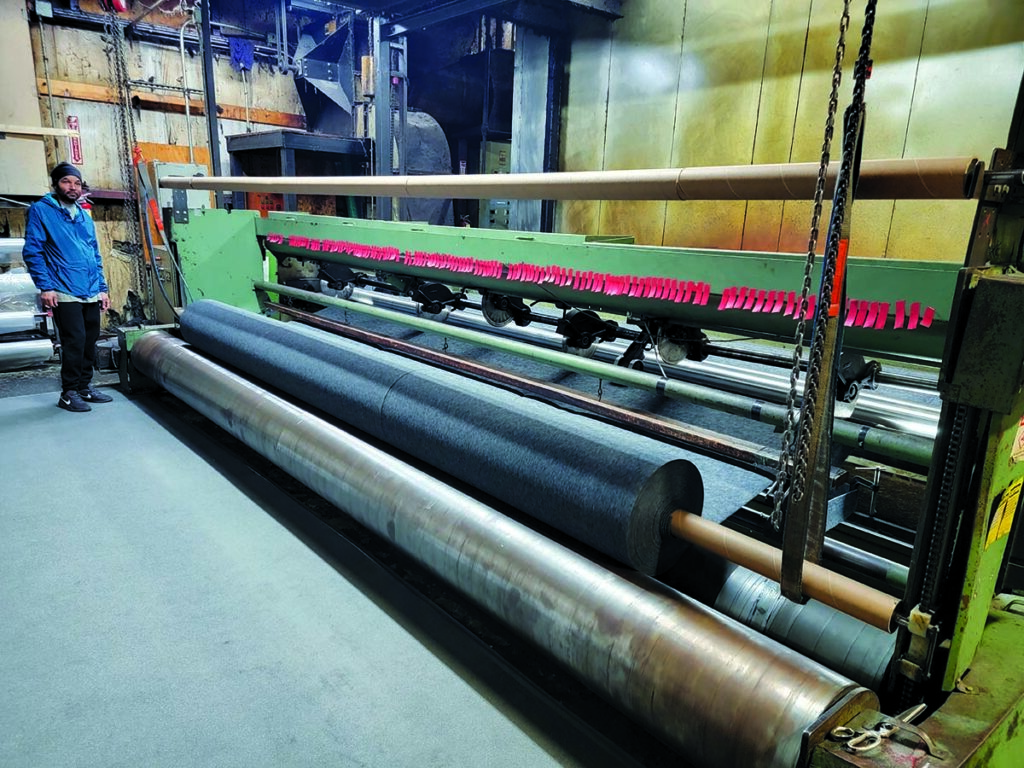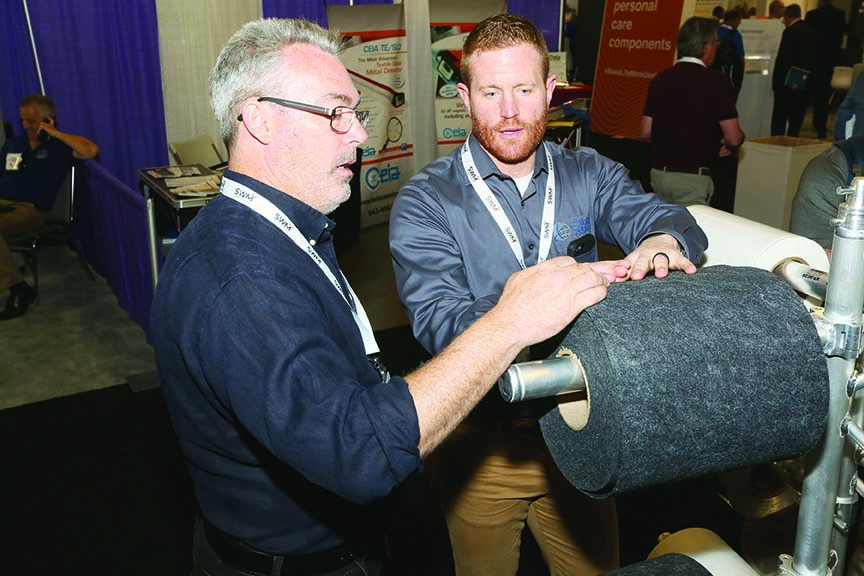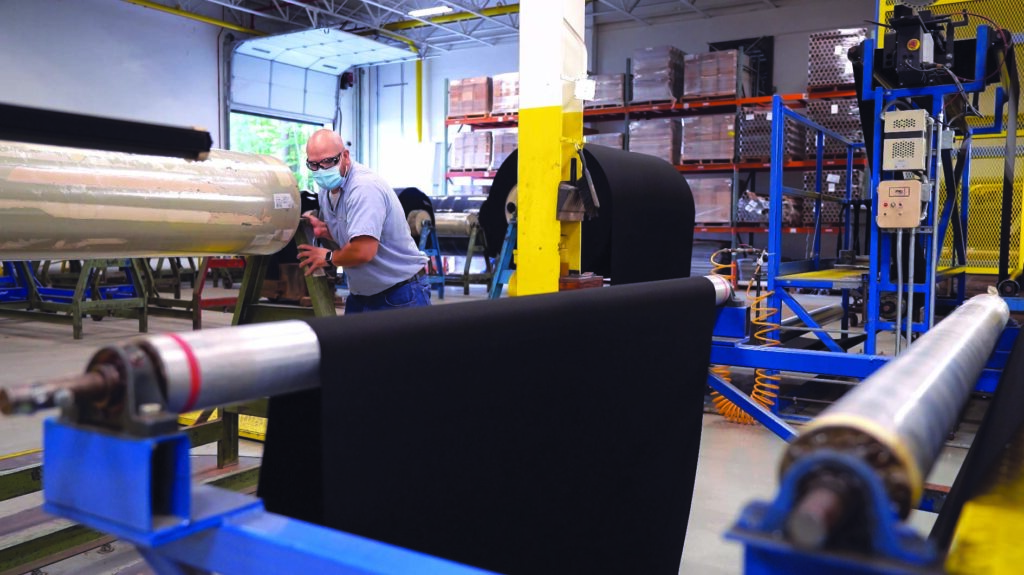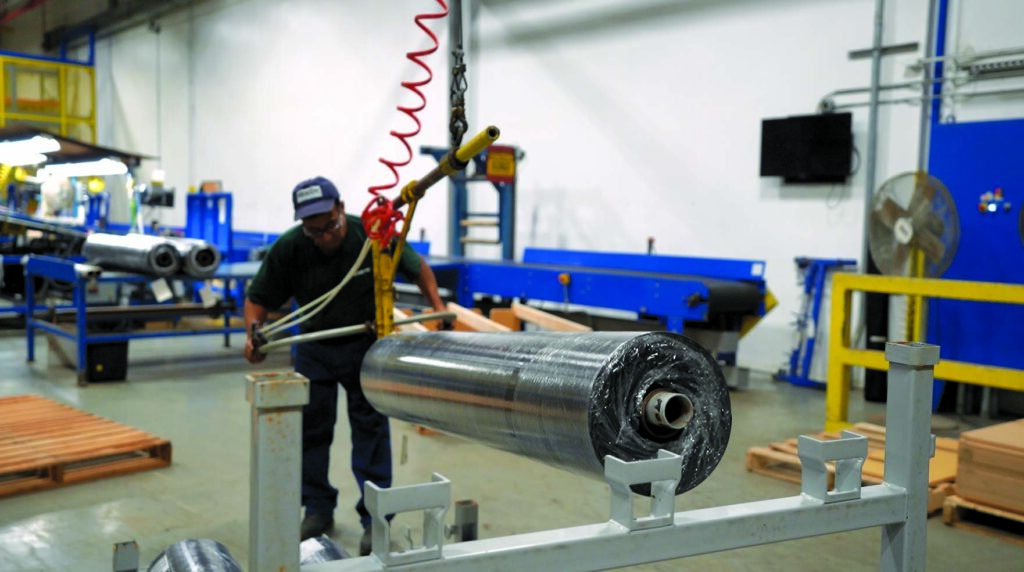Given the amount of attention sustainability efforts in the nonwovens industry have gotten in the past few years, it’s easy to think these conversations and initiatives are relatively new. The truth is that they’ve been part of the industry for decades.

“In graduate school in 1979, I read the book Energy Future: Report of the Energy Project at the Harvard Business School, and it really struck me,” says D. Paul DiMaggio Jr., CEO of Delaware Valley Corp., which manufactures nonwoven fabrics in Tewksbury, Mass. “I thought at the time, ‘We really have to think about what we’re doing with the planet.’ And in fact, even before that, the company had been talking about thermal bonding.”
As distractions from the pandemic continue to fade, the nonwovens industry is regrouping to look hard at issues like sustainability and environmental regulations. DiMaggio says that ongoing sustainability efforts are essential for any nonwovens business that wants to survive.
“We dug into thermal bonding in the 1980s, introducing a combination of regular- and low-melt fiber,” DiMaggio explains. “Thermal bonding doesn’t drive off water vapor or toxins, it just heats the fabric. There is some effluence, but not much, and we recapture most of it because we capture the heat in heat exchangers, which is done for energy sustainability. We’ve been a proponent of it, and we’ve been successful—we’re still here and going strong.
“We now have every one of our ovens with a heat exchanger on it; that’s how we preheat the fabric and how we heat the factory, and it saves roughly half the annual gas bill,” he adds. “For 15 years I was trying to figure out how we could take our back-coated fabrics and turn them back into something usable, but you really can’t. We have built a couple of machines that can strip the fibers out of thermal-bonded, not full-length, but an inch and a half or two inches, and we turn it back into the fiber components.
“When you figure how much you throw out in waste fiber a year, it’s amazing,” he says. “Everybody recycles their trim waste before coating, and we recycle it after thermal bonding, which really can’t be done with back-coated fabrics. That’s what is critical—sustainability and recovering energy and your raw materials. It’s crucial to our survival.”

Pace of regulation increases
In concert with sustainability concerns, the industry is dealing with increasing environmental regulation efforts, which present their own set of challenges. Tony Fragnito, president of INDA, the Association of the Nonwoven Fabrics Industry in Cary, N.C., believes the biggest issue related to regulation is that efforts to enact regulations may be going too quickly.
“There are concerns about the pace and focus of regulators in the space, and it’s primarily around regulators not fully grasping the technical realities and the real-world implications of the regulations being proposed,” says Fragnito.
“Obviously, it’s fairly easy to focus people on certain environmental topics, but you really have to put them into context,” he says. “One concern is that regulation is going to push issues faster than existing technology and innovations can properly address. I’m seeing a lot of innovation and investment in this industry to introduce more sustainable inputs, circularity and end-of-life options, which need time to become viable on a large scale.
“It takes time and large investments in research, scaling production of innovative raw materials and equipment to manufacture these new materials. We are seeing large investments and focus on solutions to the issues of more environmentally conscious products, but it’s an evolution, not a revolution.”
To help industry players at every level, Mark Snider, INDA’s chief market and industry analyst, says the group has ramped up its educational offerings by adding training courses, webinars and white papers. “Part of the driving force behind investing in our training division is to educate the regulators. Sometimes a deeper understanding of technical textiles is required to make informed decisions.”

International market pressures increase
Market pressures are also on the upswing. Beyond inflation concerns and the talk of recession, Fragnito says that now that the supply chain and some shipping logistics are loosening up, the association is hearing from members that materials are “showing up on our shores, with a strong indication they might be subsidized.
“With unit costs that are very low, this puts pressure on our domestic products,” he says. “It can be a very difficult situation to be competitive when there are unfair advantages in some parts of the world. Some goods are coming in at less than the raw materials cost to make the same materials domestically, and that’s concerning.
“Our members, many who are international, view tariff and trade issues very differently, so we’re kind of walking a fine line in some respects,” he explains. “We’re for fair trade practices, and we can point to some practices which could clearly be considered unfair. Legal options are pretty limited, very expensive and long term. We are thinking about multiple approaches as we educate regulators, endorse fair trade practices and advocate for tariff policy as a tool to ensure fair global trade practices.”

Education and collaboration are key
Dave Nelson of St. Paul, Minn., who has more than 35 years of experience in nonwovens technology, including extensive work in industry engagement and education, believes that industry collaboration will be critical to success going forward.
“Very few companies in the world today can solve the big problems themselves,” he says. “They just don’t have the experience, culture or resources to take on fundamental problems that could lead to great opportunities. Regulatory pressure is going to continue to build, and they can’t really fight that too much. They don’t know what the regulations are eventually going to be, but whoever figures it out with the best collection of solutions is going to win the marketplace.”
“A lot of companies don’t like to talk to each other,” adds Nelson. “They’re concerned about intellectual property protection, market protection, and other kinds of things. There’s not a real good open environment. But it often takes something major like this current environment to change the dynamic.”
Cost increases reverberate
A roller coaster is an apt image for the past few years of business results for many companies, including the Haartz Corp., a leading supplier of automotive topping fabrics and interior trim materials based in Acton, Mass. Business cooled off significantly in the last half of 2022, says Matt Williams, Haartz’s vice president, global automotive exteriors and new markets, which includes both nonwoven and woven fabrics. “That happened because pent-up consumer demand was exhausted. Purchasing was overdone because people in the supply chain were worried they weren’t going to get product, so they bought extremely long, didn’t need the material and then cut back on purchases.”
That came after supply chain volatility. “Excessive purchasing in late 2021 and 2022 caused shortages of raw materials,” says Williams. “It was so bad in some instances that even a minor natural disaster or accident at a manufacturing site halfway around the world would lead to a disruption that would impact us for months, because everything was so tight.
“Over the course of 2022, especially in Europe with the rapidly escalating costs of energy and raw materials, those increases in costs and the softening of demand has led to many companies having financial distress in the supply chain,” he adds.
Despite all the noise in the marketplace, Williams says it remains important for companies to listen to the voices of their customers. “We are very attuned to that; in our case it’s the OEMs. It’s how new products are designed and developed. We tend to follow design-driven megatrends where a given color palette is trending or a given type of texture for trim materials,” he says.
“It includes a socioeconomic megatrend like sustainability,” notes Williams, “where we’re looking at products, trying to figure out ways to reduce their weight so cars are more fuel-efficient or use more environmentally friendly materials that have less carbon impact as they’re manufactured.”
In the end, DiMaggio says the industry will be successful by continuing to try to find ways to meet consumer demand and preferences. And he says there is more than one way to do that.
“My father impressed on me to save a buck any way you can if it doesn’t demoralize the employees or compromise quality. You don’t want to make your profits on the backs of your employees, because they’re crucial. But every penny you save is 10 cents in sales you don’t have to make. That could be a guiding principle for the earth. Maybe we are producing too much—rather than focusing on how efficiently we can produce things.”
Jeff Moravec is a freelance writer based in Brooklyn Park, Minn.
SIDEBAR: New Finish for Nonwovens
Challenges often spur innovation, and that’s true for the nonwovens industry. Sustainability and regulation issues have encouraged many companies to think more creatively.
One example is the Haartz Corp., a leading supplier of automotive topping fabrics and interior trim materials, based in Acton, Mass. It recently announced a partnership with Green Theme Technologies Inc. (GTT), a leader in waterless and per- and polyfluoroalkyl substances (PFAS)-free textile finishing, to “revolutionize how textiles are finished in the U.S.,” says Matt Williams, Haartz’s vice president, global automotive exteriors and new markets.
The first of its kind in the North American market, GTT’s EMPEL™ textile finishing process eliminates harmful chemicals from all levels of textile finishing to create a long-lasting protective finish.
Developed by GTT, the EMPEL process can apply a wide variety of finishes, including durable water repellent, anti-wicking, durable stain release and more, to an almost limitless number of textiles. EMPEL uses sustainable “clean chemistry” to eliminate contamination by PFAS during the textile manufacturing process by using a waterless process.
 TEXTILES.ORG
TEXTILES.ORG


